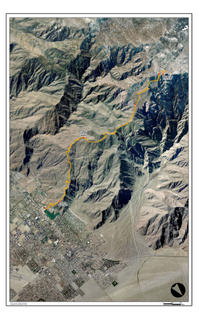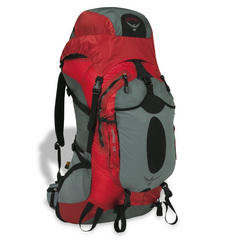
Palm Springs Skyline Trail to the Tram
Date: 2005-6-21
Distance: 10-11 miles (truth is, nobody really knows for sure)
Elevation Gain: 8400 feet
Duration: 10 hours
This was the last training hike before the Big One. The main goal obiviously was to condition my body to acclimate to the rapid elevation gain (>800 feet per mile). Also to take Superfeet out on a test drive to see if it indeed lives up to its praises.
Due to bad planning (yes, again), unbelievably congested traffic from LA to Palm Springs, and just to make things more interesting, a minor accident that involves a garden sprinkler, we didn't start the hike until 7AM, 3 hours behind our planned start time. Unlike any of the previous hikes all without exception had a relatively easy start, Skyline, from step one, unquestionably and undeniably claimed itself as the hardest trail we've ever set foot on. Like an experienced boxer sending a full-forced punch straight to a newbie's chest, we were hit with the steepness and roughness of the terrain without any cushioning period. Every step was a huge effort, more so as we progressed along the cactus-littered trail that climbs up and down several mountain ridges. It was mid-June, but the heat from the blazing sun was rlentlessly stripping away every ounce of moisture and energy we had, on a trail with no mercy of shades or trees until late afternoon after we reached alpine terrain at 6000 or 7000 feet. It is a shame to admit that I started feeling muscle pain 30 minutes into the hike, and it wasn't even a mile from the trailhead!
The trail itself was very interesting now come to think of it sitting comfortably at my desk typing away. It's nicknamed "Cactus to Cloud", meaning that during the 8600-feet ascend, you will encounter flora and fauna of the desert and the alpine, which, as it turned out, was our only method to determine how far and how high we'd gone so far. At lower elevation, we had seen all kinds of desert plants. Abundant were various cacti, Saguaro, Beavertail, Hedgehog, and Prickly Pear, dry yellow Ocotillo, Buckhorn, Yucca, Palo Verde, Spanish Bayonet with their razor-sharp pointy leaves that cut through the pants like needles as we bushwacked our way up. Three hours into the trail, the initial interest in desert plants waned to plain old frustration. All I could think was, "I wish I am not seeing these damn cacti!" or "When I go pass this hill, all the cacti will be gone and I will start seeing pine trees". Oh no, that didn't happen until 7 hours into the trail, and just like a puff of magic, all the cacti, Joshua Trees, Yucca and its cousins were gone, and our eyes welcomed the soothing sight of green pine trees and black soil.
This hike also made me realize the importance of self-reliance, more specifically, the need of a good GPS. Surprisingly, for such a popular route, it does not have any mark other than the death-warning sign at the 2-mile point. We had no idea how far we had gone and how much further it was to the summit. This posed as more of a psychological threat than that of a physical one. For example, one cannot freely drink up water and other fluid, nor can one eat as much as the growling stomach commands in fear that water and food would run out before the summit, and a rescue services would have to be called for. The only way to go was to conserve. Eat and drink just enough to quench the flaming throat and calm the stomach, and with great faith keep on moving one foot in front of the other. Hikers before us tied white ribbons, shoelaces, and pieces of cloth under rocks to serve as trail marks. I grew so grateful to them as every time just when I was about to give up and torturing myself with the idea "Are we lost?" a piece of white will pop into my eyes, and I was once again reassured that we were on the right track. I have never before understood so deeply the importance of a good sense of direction, and if not that, good mark on a trail in the wild. Along the trail, when I saw a while ribbon had fallen off the tree branches, I'd stop and tie it back on the branch for hikers after us.
Needlessly to say, the gratifying satisfaction when we reached the Tram was overwhelming… People stepped out of the Tram station stared at us. We must've looked like hell. Everybody was wearing bright color T-shirts, clad in sunscreen, men in khaki shorts, and women in skirts and heeled shoes. We enjoyed a free ride down. Even though I had hiked up here step by step, from 200 feet to 8500 feet in 10 long hours, it took us 15 minutes to get down.


